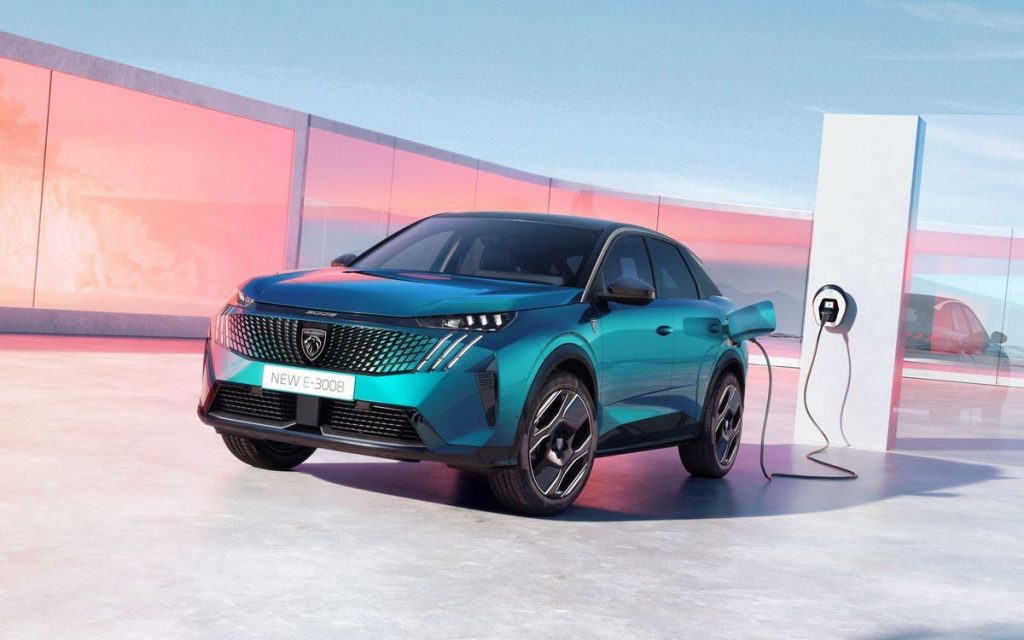For many years, Tesla has been the champion of electric car range. The Model S was the top of the rankings until the Mercedes-Benz EQS challenged it, and even then, for more money and less performance. But now there’s a new competitor, and it’s not the brand you’d expect. It’s venerable French carmaker Peugeot. The recently launched Peugeot E-3008 boasts a WLTP range of 435 miles, where the latest Tesla Model S only goes to 405 miles, and the Project Highland Tesla Model 3 will offer 420 miles.
The new Peugeot E-3008 was launched on Tuesday with a theatrical unveiling in Sochaux, France, showing the importance Stellantis is placing on this car. This is because it is the first product of the company’s new electric era. It’s based on the new STLA Medium platform. At launch, there will be three choices of drivetrain for the E-3008. There’s a front-wheel drive version with a 210kW (210bhp) motor and 73kWh (net) battery, a Dual Motor all-wheel-drive version with the same battery but 240kW (320bhp), and another front-wheel-drive Long Range version with a 170kW (230bhp) motor and a 98kWh (net) battery.
While the 73kWh cars offer a decent 326 miles of WLTP range – a huge improvement over previous Stellantis EVs – the Long Range 98kWh option is the most significant development. This version is the one that boasts 435 miles of WLTP range, which will be class leading. The Peugeot E-3008 won’t be a particularly fast car by EV standards, with even the Dual Motor version taking 6.4 seconds to hit 62mph and the other two options closer to 9 seconds. These are relatively pedestrian figures considering the keenly priced MG4 XPOWER takes just 3.8 seconds
The 21in wraparound Panoramic i-Cockpit is a significant step forward for Stellantis dashboard and infotainment, but this is a mid-range brand rather than premium. The interior is comfortable and there is a decent amount of cargo space in the rear (520 liters with the rear seats up and 1,482 liters with them down). Rear passengers have good headroom and legroom, too. This is an affordable, well-constructed car for families, not an ostentatious luxury vehicle.
That is why the 435 miles of range are significant. We have come to expect this kind of figure from cars costing close to £100,000 ($124,000) or more. Although the company didn’t divulge any definite details about how much the E-3008 would cost, one Stellantis representative implied to me that the 98kWh version should be available for around £45,000 ($56,000). The Tesla Model 3 Long Range is considerably more expensive in the UK, and the Y even more.
There will be more Peugeots based on the STLA Medium platform alongside Small and Large variants that Stellantis announced in 2021, too. Stellantis may have achieved its huge range by using a huge battery (that 98kWh figure is net, so the cells have an even larger gross capacity), but it’s a watershed moment in the EV market’s progress when a mid-range brand offers 435 miles of range. It implies that it won’t be long before electric vehicles with more modest range and costs hit price parity with their internal combustion engine (ICE) competitors.
Apparently, the STLA Medium platform can still accommodate ICE. But unlike the previous E-CMP platform, STLA Medium was designed for EVs first, and will then be adapted for ICE. E-CMP was the other way round, making it a compromise for electric cars. Despite Stellantis CEO Carlos Tavares’s ambivalent comments about EVs, the company is putting electrification first, while realizing there are still a few years left in the ICE market to profit from.
Stellantis has also been quite clever in how it incorporates the larger 98kWh battery. Although right now there is no dual-motor E-3008, the extra battery capacity doesn’t take up the rear motor space. Instead, Stellantis uses a slightly deeper pack in its skateboard design (where the battery sits in the middle between the front and rear wheels across the width of the vehicle). This reduces the ground clearance by around 15mm, but the interior space remains exactly the same as the 73kWh front-wheel-drive car.
Stellantis has made some compromises with the Peugeot E-3008. The platform is still based on 400V rather than 800V technology, to cut costs. But it still supports DC charging up to 160kW, so even the 98kWh battery will take around 30 minutes to go from 20% to 80%. There is a Vehicle to Load (V2L) capability enabling the E-3008 to power external devices up to 3kW at 16A. So you’ll be able to run the pump for a bouncy castle or supply an al fresco home cinema projector when camping.
For Americans, the E-3008 might seem irrelevant, since Peugeot hasn’t been selling cars in the US for over 30 years. But there are two things to consider. First, Peugeot is part of Stellantis, which owns several iconic American brands including Jeep, Chrysler, Dodge and RAM. And while Peugeot’s former plans to return to the US market as a brand have waned, there are other European marques owned by Stellantis that are available, including Alfa Romeo, Fiat, and Maserati. The STLA Medium platform will be made available to most of these brands, and Stellantis has 22 factories in America (albeit two currently idle), six in Canada and seven in Mexico. In other words, it’s likely to be making some affordable STLA Medium-based long-range EVs for the North American market too.
While the Peugeot E-3008 isn’t perhaps a halo car that will change the electric vehicle market overnight, it’s an important milestone. The Peugeot E-3008 will go on sale in February 2024, meaning the range available in the mid-market will be at least 435 miles from next year. One of the frequent criticisms EV haters make is that electric cars don’t go far enough compared to ICE. But the 435-mile Peugeot E-3008 shows that pretty soon, they will.
Read the full article here










